Product_Placement_IJOA_pre_pub
Ecommerce Marketplace Networks 商品说明书

Table of Contents1. About (2)About Product (2)System Requirements: (3)2. Installation (3)Step 1: Unzip Package (3)Step 2: Install (3)Step 3: Upgrade (4)Step 4: Deloy (4)Step 5: Clean cache (4)3. How to use this extension? (5)Configuration in back-end (5)Store Locations Management (9)✓Add New Store Location (9)✓Delete Store Location (15)Schedules Management (15)✓Add New Schedule (15)✓Delete Schedule (19)Overview extension in front-end (19)4. Uninstall (21)✓Step1: (21)✓Step 2: Uninstall (22)5. Support and Contact Information (24)Support (24)Contact Information (25)Copyright© 2011-20171.A boutAbout Product:Author Netbase TeamVisit us Store Locator Extension For Magento 2Change log Click to viewVideoSupport @Support Service; @CMSMart ForumLicense OSL-3.0You are a shop owner, you have a powerful website and a chain of offline stores but your customers hardly find your local stores, then you lose a huge of customers. Store Locator Extension for Magento 2 is an effective solution that you must integrate into your site to resolve this problem. It shows all store locations, show each store's info including images,open/close time, store description... and allow your customer search for closest stores by distance, zip code, state etc.Copyright© 2011-2017System Requirements:* Operating System:- Linux as RedHat Enterprise Linux (RHEL), CentOS, Ubuntu, Debian, v..v - Composer (the last version)- Apache 2.2 or > Apache 2.2- PHP 5.6.x; 5.5.x - where x is 22 or greater; 7.0.2, 7.0.6 up to but not including 7.1, except for 7.0.5* PHP extensions requirement:- PDO/MySQL- Mbstring- Mcrypt- Mhash- Simplexml- Curl - gd2, ImageMagick 6.3.7 (or later) or both- Soap* My SQL:- MySQL 5.6.x- Mail Transfer Agent (MTA) or SMTP server2.I nstallationThere are 5 steps to install this extension:Step 1: Unzip Package∙Unzip file from your folder. It includes:∙Continue to unzip. It includes:Step 2: Install∙Coppy folder into your root magento folderCopyright© 2011-2017Step 3: Upgrade∙Go to your root magento folder -> bin by Commandline∙From command window, you write: php magentosetup:upgradeStep 4: Deloy∙Go to your root magento folder -> bin by Commandline∙From command window, you write: php magento setup:static-content:deployStep 5: Clean cache∙In admin panel, go to System -> Cache ManagementCopyright© 2011-2017Copyright © 2011-2017∙ In Mass Action, choose “Select All ” -> Click on button3. H ow to use this extension?Configuration in back-end∙ In admin panel, click onSTORE LOCATOR -> SettingsCopyright© 2011-2017Locator View Setting Copyright© 2011-2017Copyright © 2011-2017∙ Enable Locator On Frontend: Turn on/ Turn off module.∙ Latitude of Center Default: fill on the default latitude for map. ∙ Longitude of Center Default: fill on the default longitude for map.∙ Zoom Default Level: fill in value of zoom default level for map. ∙Distance Unit: Select a default distance unit (Miles/Kilometers). ∙ Remembering after each change.Service API∙Google Map API Key:fill in Google map api. To get a Google map api key, you follow link below:https:///maps/documentation/javascript/get-api-key∙Enable Comment By Facebook: Choose Yes to enable Facebook comment for your stores.∙Remembering after each change.Store Locations ManagementIn admin panel, go to STORE LOCATOR -> Manage Store Locations ✓Add New Store Location∙Step 1: In Manage Store Location, click onCopyright© 2011-2017Copyright © 2011-2017Step 2: Add New Store Location - In TabGoogle Map LocationCopyright© 2011-2017+ Address: specific a exact address that will be displayed on front-end.+ Country: select country for this store location.+ State/Province: fill in state/province of store location.+ City: fill in city of store location.+ Zip Code: fill in zip code.+ The exact location coordinates can be defined automatically after you fill location address in box “Enter a location”.- In Tab Store InformationCopyright© 2011-2017Copyright© 2011-2017+ Store Name: fill in store location name.+Identifier: fill in identifier. Please enter a valid XML-identifier (Ex: something_1, block5, id-4).+ Status: You can enable/disable the location display on the map.+ Select schedule: select schedule for this store location. To create a schedule, you can view guide “Add New Schedule” below.”+ Store Link: fill in store link for this location.+ Store Image: Upload an image for each store that will be displayed on the frontend map.+ Store Order: fill in sort order that is display in the store list in the left sidebar.+ Description: Specify additional description for this store location.-In tab Contact Information:+ Fill in Email, Phone Number and Fax Number of this store location. Copyright© 2011-2017∙Step 3: Rememberingafter adding location.✓Delete Store Location∙In manage store locations page, you tick to select the store locations you want to delete -> select “Delete” in ActionSchedules ManagementIn admin panel, go to STORE LOCATOR -> Manage Schedules ✓Add New Schedule∙Step 1: In manage schedule page, click onCopyright© 2011-2017Step 2: Add new schedule-In tab General Information : Copyright© 2011-2017+ Schedule Name: fill in schedule name for each store location.+ Status: enable/disable schedule on the front-end.- In Tab Schedule Content:Copyright© 2011-2017Copyright© 2011-2017Copyright © 2011-2017+ You select open/close time for each day. ∙Step 3: Rememberingafter adding schedule.✓ Delete Schedule∙ In manage schedules page, tick to select schedules you want to delete -> select “Delete” in Action✓Setail Store Locator page Copyright© 2011-20174.U ninstallStep1:In admin panel, go to Store →Configuration Copyright© 2011-2017Step 2: UninstallIn Configuration window, click on ADVANCED -> select AdvancedCopyright© 2011-2017Select Disable in Netbaseteam_Locator Copyright© 2011-2017Click on5.S upport and Contact InformationSupportOur Magento team is dedicated to providing customers with the best Quality, Value and Services. We would love to hear from you. For feedback about our products, please feel free to contact us at:@Support ServiceCheck out our Forum for updates and news.@CMSMart ForumCopyright© 2011-2017Contact InformationCheck out our Facebook page! Regional news and specially selected products are featured daily.@CMSMart on FacebookYou can also follow us on Twitter!@CMSMart on TwitterIf you have any question, don’t hesitate to contact us:Administration department: *****************Sales department: *****************Copyright© 2011-2017。
AutoPlay Media Studio6.0简体中文版使用指南
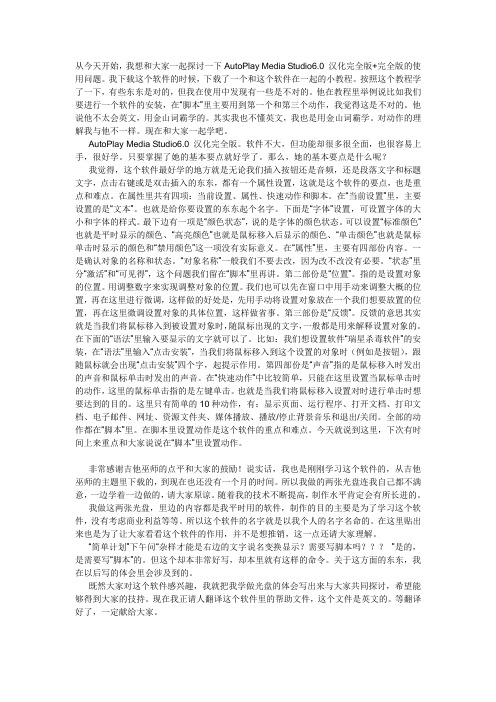
从今天开始,我想和大家一起探讨一下AutoPlay Media Studio6.0 汉化完全版+完全版的使用问题。
我下载这个软件的时候,下载了一个和这个软件在一起的小教程。
按照这个教程学了一下,有些东东是对的,但我在使用中发现有一些是不对的。
他在教程里举例说比如我们要进行一个软件的安装,在“脚本”里主要用到第一个和第三个动作,我觉得这是不对的。
他说他不太会英文,用金山词霸学的。
其实我也不懂英文,我也是用金山词霸学。
对动作的理解我与他不一样。
现在和大家一起学吧。
AutoPlay Media Studio6.0 汉化完全版。
软件不大,但功能却很多很全面,也很容易上手,很好学。
只要掌握了她的基本要点就好学了。
那么,她的基本要点是什么呢?我觉得,这个软件最好学的地方就是无论我们插入按钮还是音频,还是段落文字和标题文字,点击右键或是双击插入的东东,都有一个属性设置,这就是这个软件的要点,也是重点和难点。
在属性里共有四项:当前设置、属性、快速动作和脚本。
在“当前设置”里,主要设置的是“文本”。
也就是给你要设置的东东起个名字。
下面是“字体”设置,可设置字体的大小和字体的样式。
最下边有一项是“颜色状态”,说的是字体的颜色状态。
可以设置“标准颜色”也就是平时显示的颜色、“高亮颜色”也就是鼠标移入后显示的颜色、“单击颜色”也就是鼠标单击时显示的颜色和“禁用颜色”这一项没有实际意义。
在“属性”里,主要有四部份内容。
一是确认对象的名称和状态。
“对象名称”一般我们不要去改,因为改不改没有必要。
“状态”里分“激活”和“可见得”,这个问题我们留在“脚本”里再讲。
第二部份是“位置”。
指的是设置对象的位置。
用调整数字来实现调整对象的位置。
我们也可以先在窗口中用手动来调整大概的位置,再在这里进行微调,这样做的好处是,先用手动将设置对象放在一个我们想要放置的位置,再在这里微调设置对象的具体位置,这样做省事。
第三部份是“反馈”。
反馈的意思其实就是当我们将鼠标移入到被设置对象时,随鼠标出现的文字,一般都是用来解释设置对象的。
Supplier Assessment Report 供应商评估表1
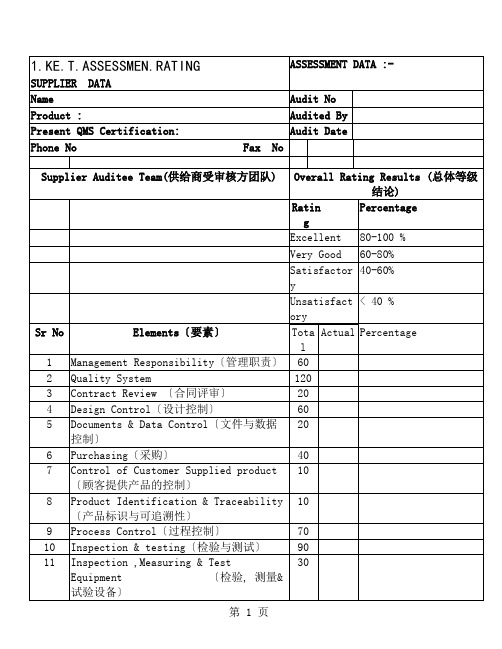
ELEMENTS NOT APPLICABLE TO A PARTICULAR SUBCONTRACTOR〔不适合特殊分供方的条款〕Certai.element.suc.a.4..(Contro.o.Custome.Supplie.Product.an.4.1.(Servicing.w il.no.appl.t.ever.supplier.I.suc.cases.‘N/A.i.entere.i.plac.o.th.score.REPORTING OF ASSESSMENT FINDINGS〔审核结果的报告〕The supplier assessment report shall be filed along with this assessment form for reporting and recommendation on supplier selection and approval.〔供给商评估报告应连同此评估表格作为报告、建议新供方的选择以及批准〕MINIMUM CRITERIA FOR ACCEPTANCE〔新供方承受的最小准那么〕1. The supplier (including Specially designated small supplier〔包括指定的特别小供方〕) should score minimum 40-60% & score minimum 5 points on the following elements individually for acceptance as approved supplier.〔至少得分在40-60%以及至少分别在下面条款中得到5分, 方可批准为供方〕2. Product identification and traceability.〔产品标识与可追溯性〕3. Control plan.(控制方案)4. Contract review.〔合同评审〕5. Control of customer supplied products.〔顾客财产保护〕6. Process monitoring operation instructions.〔过程监控作业指导书〕7. Control of non confirming products.〔不合格品控制〕8. Inspection status.〔检验状况〕9. Calibration status.〔校验状况〕10. Corrective action on customer complaints.〔客户抱怨纠正行动〕11. Compliance with customer's standards/requirements.〔遵守客户标准与要求〕12. Control of quality records〔质量记录控制〕-▪------------------ASSESSMENT DONE BY: Signature:Name:Date:。
目标产品概述
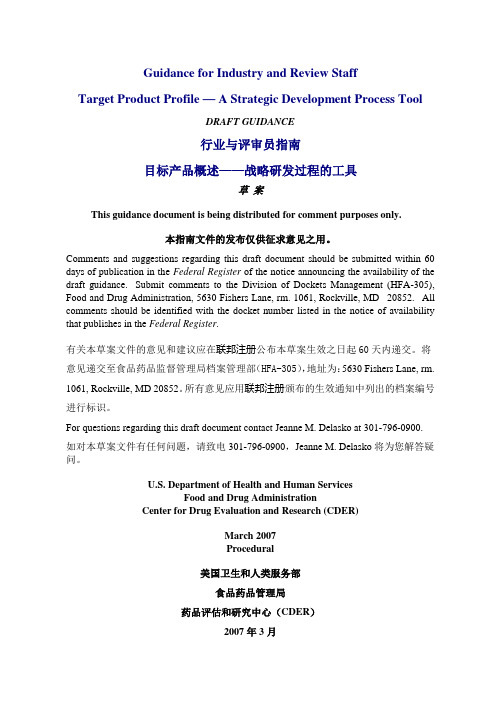
Guidance for Industry and Review StaffTarget Product Profile — A Strategic Development Process ToolDRAFT GUIDANCE行业与评审员指南目标产品概述——战略研发过程的工具草案This guidance document is being distributed for comment purposes only.本指南文件的发布仅供征求意见之用。
Comments and suggestions regarding this draft document should be submitted within 60 days of publication in the Federal Register of the notice announcing the availability of the draft guidance. Submit comments to the Division of Dockets Management (HFA-305), Food and Drug Administration, 5630 Fishers Lane, rm. 1061, Rockville, MD 20852. All comments should be identified with the docket number listed in the notice of availability that publishes in the Federal Register.有关本草案文件的意见和建议应在联邦注册公布本草案生效之日起60天内递交。
将意见递交至食品药品监督管理局档案管理部(HFA-305),地址为:5630 Fishers Lane, rm. 1061, Rockville, MD 20852。
集成产品开发流程(IPD)实战应用 For 浪潮集团

4
《集成产品开发流程(IPD)实战应用》培训班
2
项目管理 研发管理 产品管理 领航者
中国企业产品开发管理的典型问题
1 缺乏系统、正确的产品管理理念 2 缺乏前瞻性、有效的产品规划 3 在产品全生命周期过程中缺乏例行的系统的业务决策评审 4 职能化特征明显的组织结构阻碍了跨部门的协作 5 不规范、不一致、串行的产品开发流程 6 项目管理薄弱(包括进度、质量、成本、风险等) 7 技术开发与产品开发未分离,缺乏技术规划与运作机制 8 缺乏共用模块(CBB)与经验教训的积累及共享机制 9 缺乏有效的产品导向的考评和激励机制 10 缺乏有效的培养机制,产品管理人员的职业化素质不足
成功标准/关 注点
结构
流程
项目管理
产品战略及 规划
级别L1 不明确的目标
不明确、不清晰 无纪律状态 无原则性 无
级别L2 不一致的目标
职能化 各职能的工作流程 协调不畅 无原则、流于形式
级别L3 产品取得市场 成功 跨部门团队 统一的跨部门流程 高效协作
有效引导产品开发
级别L4 以平台推动产品持续 成功 异步开发的组织平台 流程成为战略优势 管道平衡、高效
15
活动 2
活动 3
客户需求 被满足
• 狭义的产品:指具有某种特定物质形状和用途的物品,是看得见、摸得着的 东西。
• 广义的产品:即指产品包,指人们通过购买而获得的能够满足某种需要和欲 望的物品总和,它既包括具有物质形态的产品实体,又包括非物质形态的利益。
品牌 安装
核心产品占总 成本的80%
包装
心理产品 附加产品 有形产品 核心产品
指导 质量
《集成产品开发流程(IPD)实战应用》培训班
产品经理的prd模板
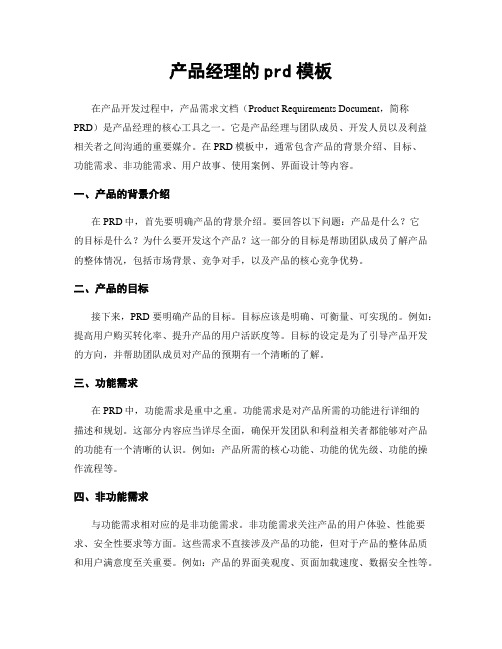
产品经理的prd模板在产品开发过程中,产品需求文档(Product Requirements Document,简称PRD)是产品经理的核心工具之一。
它是产品经理与团队成员、开发人员以及利益相关者之间沟通的重要媒介。
在PRD模板中,通常包含产品的背景介绍、目标、功能需求、非功能需求、用户故事、使用案例、界面设计等内容。
一、产品的背景介绍在PRD中,首先要明确产品的背景介绍。
要回答以下问题:产品是什么?它的目标是什么?为什么要开发这个产品?这一部分的目标是帮助团队成员了解产品的整体情况,包括市场背景、竞争对手,以及产品的核心竞争优势。
二、产品的目标接下来,PRD要明确产品的目标。
目标应该是明确、可衡量、可实现的。
例如:提高用户购买转化率、提升产品的用户活跃度等。
目标的设定是为了引导产品开发的方向,并帮助团队成员对产品的预期有一个清晰的了解。
三、功能需求在PRD中,功能需求是重中之重。
功能需求是对产品所需的功能进行详细的描述和规划。
这部分内容应当详尽全面,确保开发团队和利益相关者都能够对产品的功能有一个清晰的认识。
例如:产品所需的核心功能、功能的优先级、功能的操作流程等。
四、非功能需求与功能需求相对应的是非功能需求。
非功能需求关注产品的用户体验、性能要求、安全性要求等方面。
这些需求不直接涉及产品的功能,但对于产品的整体品质和用户满意度至关重要。
例如:产品的界面美观度、页面加载速度、数据安全性等。
五、用户故事和使用案例用户故事和使用案例是PRD中的两个重要内容,用于描述用户在使用产品时的场景和具体操作。
用户故事通常以用户的角度来描述用户需求,并结合具体的使用案例来展示用户与产品的交互过程。
这部分内容有助于团队成员理解用户需求和产品的功能点。
六、界面设计在PRD中,界面设计是产品用户界面的规范和设计要求。
界面设计要求应包括整体风格、配色方案、布局、交互设计等,以确保产品具有良好的用户体验。
在这一部分中,可以通过文字和图表来描述产品的界面设计要求,但要求不得包含具体的图片。
耐久性开发技术第7节耐久目标
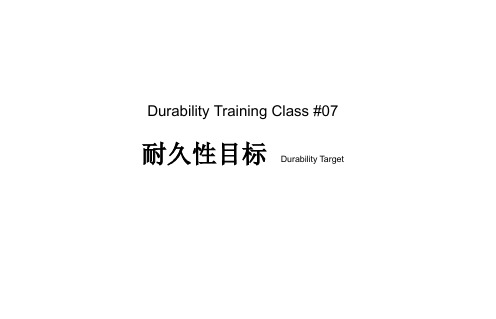
*
为耐久性质量保证的一般设计要求条件 Design requirements for LLQ
相对周期 Relative Frequency
加载力 Damage applied
*
动力总成系统质量保证 Powertrain Warranty: 因某种原因,基本质保期结束后,动力总成的质保还会延续。In some cases the Powertrain warranty continues after the basic warranty has expired. 动力总成质保覆盖了使车辆移动的大部分零部件,包括发动机、变速箱、传动桥、传动轴等。This part of the warranty covers most of the parts that make the vehicle move, including the engine, transmission, drive axles and driveshaft. 和基本质保一样,易耗品不在范围内,例如管子、扎带等。Like the basic warranty, consumable parts such as hoses and belts are not covered. 尽管发动机内部例如活塞和轴承等零部件易于磨损,但是他们也包含在动力总成的质保范围内。However, most of the internal parts of the engine, such as the pistons and bearings, which are also subject to wear and tear, are covered by the drive train warranty.
major revisions required后preproduction review
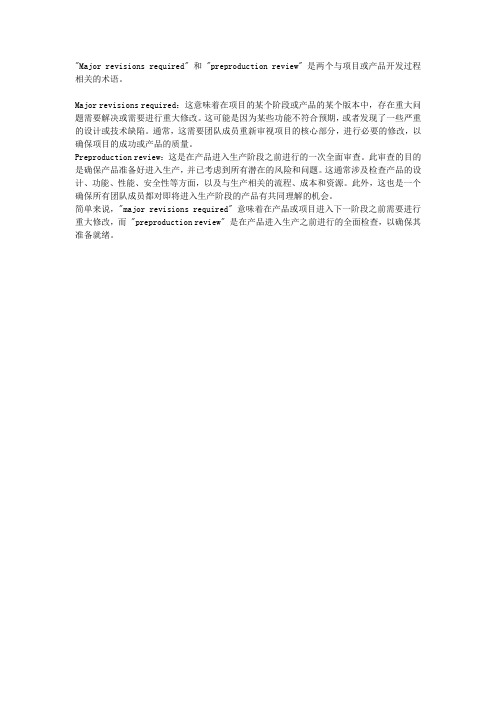
"Major revisions required" 和 "preproduction review" 是两个与项目或产品开发过程相关的术语。
Major revisions required:这意味着在项目的某个阶段或产品的某个版本中,存在重大问题需要解决或需要进行重大修改。
这可能是因为某些功能不符合预期,或者发现了一些严重的设计或技术缺陷。
通常,这需要团队成员重新审视项目的核心部分,进行必要的修改,以确保项目的成功或产品的质量。
Preproduction review:这是在产品进入生产阶段之前进行的一次全面审查。
此审查的目的是确保产品准备好进入生产,并已考虑到所有潜在的风险和问题。
这通常涉及检查产品的设计、功能、性能、安全性等方面,以及与生产相关的流程、成本和资源。
此外,这也是一个确保所有团队成员都对即将进入生产阶段的产品有共同理解的机会。
简单来说,"major revisions required" 意味着在产品或项目进入下一阶段之前需要进行重大修改,而 "preproduction review" 是在产品进入生产之前进行的全面检查,以确保其准备就绪。
ebay设计经验|十步打造一篇好PRD
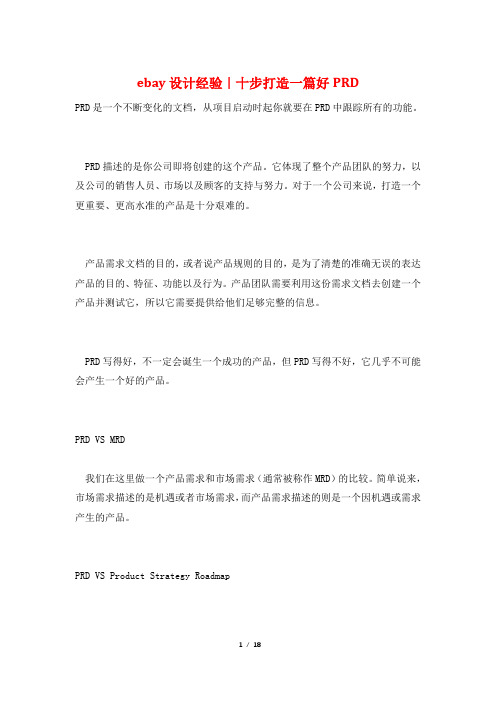
ebay设计经验|十步打造一篇好PRDPRD是一个不断变化的文档,从项目启动时起你就要在PRD中跟踪所有的功能。
PRD描述的是你公司即将创建的这个产品。
它体现了整个产品团队的努力,以及公司的销售人员、市场以及顾客的支持与努力。
对于一个公司来说,打造一个更重要、更高水准的产品是十分艰难的。
产品需求文档的目的,或者说产品规则的目的,是为了清楚的准确无误的表达产品的目的、特征、功能以及行为。
产品团队需要利用这份需求文档去创建一个产品并测试它,所以它需要提供给他们足够完整的信息。
PRD写得好,不一定会诞生一个成功的产品,但PRD写得不好,它几乎不可能会产生一个好的产品。
PRD VS MRD我们在这里做一个产品需求和市场需求(通常被称作MRD)的比较。
简单说来,市场需求描述的是机遇或者市场需求,而产品需求描述的则是一个因机遇或需求产生的产品。
PRD VS Product Strategy RoadmapProduct strategy(市场策略)描绘的是一个蓝图,比如说在2-5年之后,你的产品要走向哪;Roadmap(产品路线图)则描绘了到这里的各种步骤,而PRD 描绘的是沿着这条路所推出的一款特定产品。
十步打造一篇好PRD这篇文章的目的就是为了描述一个被证实过的、可重复使用的,创建一篇好PRD的的过程。
文章中讲的十步都不容易,但它们能帮助你诞生一个特别棒的PRD。
这个过程所花费的时间很大程度取决于你产品的尺寸和复杂度,以及你就这些知识和所需技能的准备程度。
第一步:做你的家庭作业你PRD的目标是想出一款特定的产品。
为了想出这款产品,你必须做家庭作业。
这意味着你需要去研究你的顾客,你的竞争对手,你的团队能力,以及可能用到的技术设备。
从顾客、用户、竞争对手、行业分析、你的产品团队、销售人员、市场、公司执行力、以及其他任何对这个问题有见解和有可能解决方法的同事着手。
需要准备的还有很多,同样需要注意的是,使你的团队信服产品最后能成功是你能力中一个十分重要的因素,这是你自信程度的体现,如果你的家庭作业做得好,你将越来越自信,越来越使人信服。
网购的好处英语作文好句子
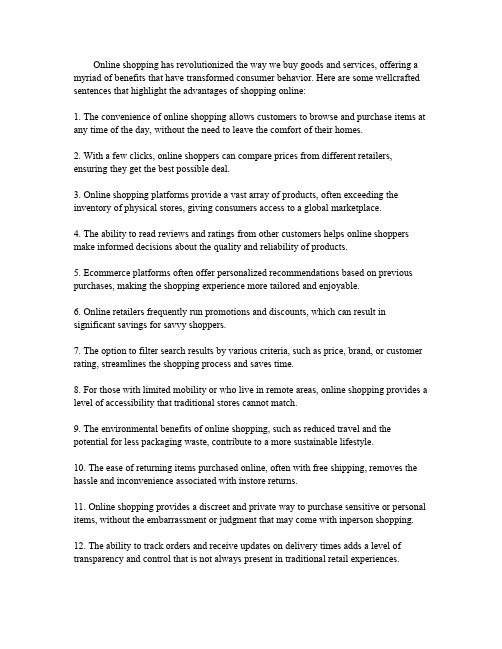
Online shopping has revolutionized the way we buy goods and services,offering a myriad of benefits that have transformed consumer behavior.Here are some wellcrafted sentences that highlight the advantages of shopping online:1.The convenience of online shopping allows customers to browse and purchase items at any time of the day,without the need to leave the comfort of their homes.2.With a few clicks,online shoppers can compare prices from different retailers, ensuring they get the best possible deal.3.Online shopping platforms provide a vast array of products,often exceeding the inventory of physical stores,giving consumers access to a global marketplace.4.The ability to read reviews and ratings from other customers helps online shoppers make informed decisions about the quality and reliability of products.5.Ecommerce platforms often offer personalized recommendations based on previous purchases,making the shopping experience more tailored and enjoyable.6.Online retailers frequently run promotions and discounts,which can result in significant savings for savvy shoppers.7.The option to filter search results by various criteria,such as price,brand,or customer rating,streamlines the shopping process and saves time.8.For those with limited mobility or who live in remote areas,online shopping provides a level of accessibility that traditional stores cannot match.9.The environmental benefits of online shopping,such as reduced travel and the potential for less packaging waste,contribute to a more sustainable lifestyle.10.The ease of returning items purchased online,often with free shipping,removes the hassle and inconvenience associated with instore returns.11.Online shopping provides a discreet and private way to purchase sensitive or personal items,without the embarrassment or judgment that may come with inperson shopping.12.The ability to track orders and receive updates on delivery times adds a level of transparency and control that is not always present in traditional retail experiences.13.For those with busy schedules,the option to have items delivered to a specified address or collection point offers flexibility and convenience.14.Online shopping platforms often provide a wealth of information about products, including detailed descriptions,specifications,and images,which can be more comprehensive than what is available in a physical store.15.The global nature of online shopping allows consumers to discover unique and niche products that may not be available in their local area,expanding their shopping horizons.These sentences capture the essence of the benefits that online shopping offers, emphasizing the convenience,variety,and accessibility that it provides to modern consumers.。
产品需求文档梳理 英文
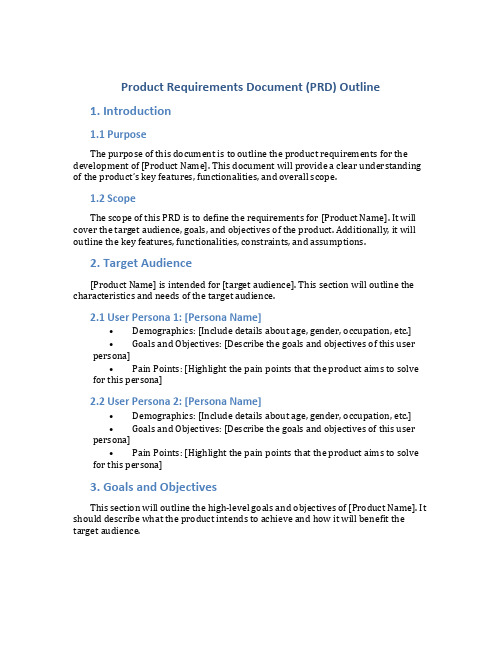
Product Requirements Document (PRD) Outline1. Introduction1.1 PurposeThe purpose of this document is to outline the product requirements for the development of [Product Name]. This document will provide a clear understanding of the product’s key features, functionalities, and overall scope.1.2 ScopeThe scope of this PRD is to define the requirements for [Product Name]. It will cover the target audience, goals, and objectives of the product. Additionally, it will outline the key features, functionalities, constraints, and assumptions.2. Target Audience[Product Name] is intended for [target audience]. This section will outline the characteristics and needs of the target audience.2.1 User Persona 1: [Persona Name]•Demographics: [Include details about age, gender, occupation, etc.]•Goals and Objectives: [Describe the goals and objectives of this user persona]•Pain Points: [Highlight the pain points that the product aims to solve for this persona]2.2 User Persona 2: [Persona Name]•Demographics: [Include details about age, gender, occupation, etc.]•Goals and Objectives: [Describe the goals and objectives of this user persona]•Pain Points: [Highlight the pain points that the product aims to solve for this persona]3. Goals and ObjectivesThis section will outline the high-level goals and objectives of [Product Name]. It should describe what the product intends to achieve and how it will benefit the target audience.4. Features and FunctionalitiesThis section will list and describe the key features and functionalities of [Product Name]. Each feature should be described in detail, providing clear explanations of its purpose, benefits, and how it aligns with the goals and objectives of the product.4.1 Feature 1: [Feature Name]•Description: [Briefly describe the feature]•Benefits: [Outline the benefits of the feature]•User Stories: [Provide user stories that demonstrate how the feature will be used]4.2 Feature 2: [Feature Name]•Description: [Briefly describe the feature]•Benefits: [Outline the benefits of the feature]•User Stories: [Provide user stories that demonstrate how the feature will be used]5. Constraints and AssumptionsThis section should highlight any constraints or assumptions that need to be considered during the development of [Product Name]. It may include technical constraints, resource limitations, or any other factors that may impact the product’s development or implementation.6. Release PlanThis section will outline the proposed release plan for [Product Name]. It should include key milestones, deliverables, and estimated timelines for each phase of the development process.7. ConclusionIn conclusion, this document provides a comprehensive overview of the product requirements for [Product Name]. It outlines the target audience, goals, key features, and release plan for the product. It will serve as a reference for the development team and stakeholders throughout the project.。
从网上买翻译成英语作文
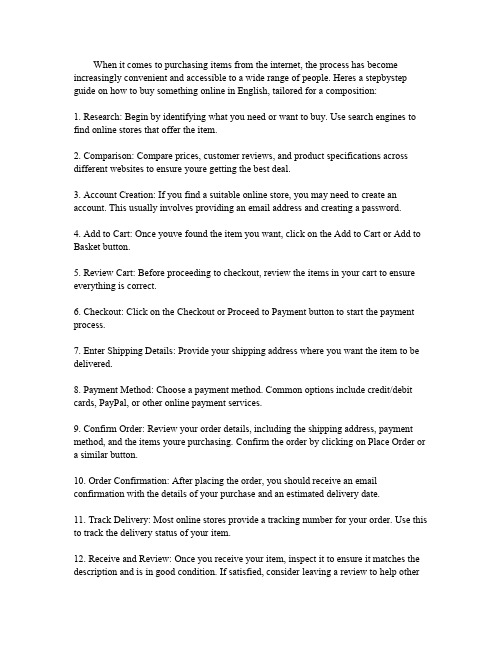
When it comes to purchasing items from the internet,the process has become increasingly convenient and accessible to a wide range of people.Heres a stepbystep guide on how to buy something online in English,tailored for a composition:1.Research:Begin by identifying what you need or want to e search engines to find online stores that offer the item.parison:Compare prices,customer reviews,and product specifications across different websites to ensure youre getting the best deal.3.Account Creation:If you find a suitable online store,you may need to create an account.This usually involves providing an email address and creating a password.4.Add to Cart:Once youve found the item you want,click on the Add to Cart or Add to Basket button.5.Review Cart:Before proceeding to checkout,review the items in your cart to ensure everything is correct.6.Checkout:Click on the Checkout or Proceed to Payment button to start the payment process.7.Enter Shipping Details:Provide your shipping address where you want the item to be delivered.8.Payment Method:Choose a payment mon options include credit/debit cards,PayPal,or other online payment services.9.Confirm Order:Review your order details,including the shipping address,payment method,and the items youre purchasing.Confirm the order by clicking on Place Order ora similar button.10.Order Confirmation:After placing the order,you should receive an email confirmation with the details of your purchase and an estimated delivery date.11.Track Delivery:Most online stores provide a tracking number for your e this to track the delivery status of your item.12.Receive and Review:Once you receive your item,inspect it to ensure it matches the description and is in good condition.If satisfied,consider leaving a review to help othercustomers.Remember,online shopping offers the convenience of shopping from home,but its important to be cautious and ensure the website is secure and reputable before making a purchase.。
Notebook开发流程-
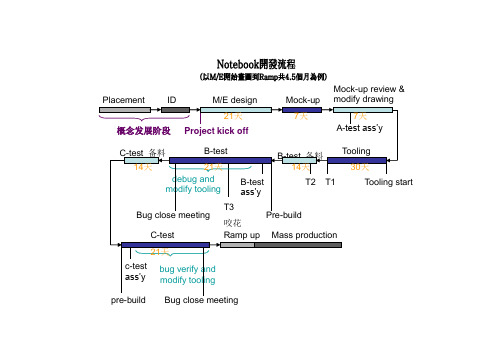
Placement ID M/E designMock-upMock-up review & modify drawing概念发展阶段Placement:架构配置,将将来可行性的架构排列给相关部门及与客户讨论,我们要同时合计如何散热,电子layout是否适宜, 上市时是否符合市场…。
时间:通常往往返返为期大约半个月~2个月之久。
注意事项:通常此阶段订单还不确定接到,RD不会公开表示此讯息图a.Placement检讨图面ID design:外型制定,客户依据我们最后谈定的架构及规格画属于他们公司风格的外型。
时间:通常为期大约半个月。
但也有遇过大约拖了两三个月的。
注意事项:1.须特别注意客户来的ID是否能做得到是否能量产,必需马上study,不符合人体工学的部份也应一起修正,因为一旦ID定案,有的客户是不容许再做任何变更的2.通常此阶段或机构制定阶段客户会提出很多不易做得到的想法,许多机构制定师一听到的想法第一个反应都是〞做不到〞,这都是不愿意去突破的思维,〞制定〞就是不一定只有一条路可行,用不同的思索方式来解决问题就是做制定师最大的乐趣,如果只愿意走传统想法,往往只会变成〞抄袭〞,充其量只能说是个〞制定作业员〞。
图b.ID外观图及色彩计划Project Kick Off 制定案正式开跑M/E design:机构制定,RD依据外型制定再去制定如何将里面所有的零件固定与合计如何组装,同时这段时间是各个部门讨论最密切的时期,也是最累的时期,以前制定时间都大约1个月,但最近大家都在拼产品上市时间谁最快,所以最近都缩减到2周~3周,但在人员没有增加的情形下,大家只能加班越加越晚。
时间: 2周~4周注意事项:1.此时期RD应将所有物料的b-test/c-test/MP的lead time弄清楚,尤其是long lead time的物料要特别注意,后续controls schedule才不会出问题。
因为又要画图又要study新技术又要见新厂商,时间会非常不够,最好集中所有厂商在某个时段统一见面,或不必要的尽量不要浪费时间。
MedmasMatix MedmasMatixsExtension用户手册说明书
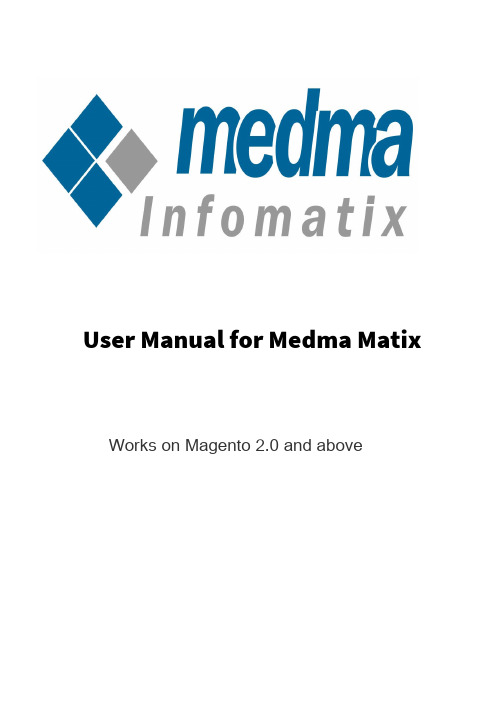
Works on Magento 2.0 and aboveMedmasMatixMedmasMatixsExtension provides a statistical dashboard for Magento 2 and WooCommerce stores which provides full-fledged details of your store data and sales. With this powerful marketing and conversion optimization tool you can show cart personalized popup window when users tend to leave your site with product inside cart. Show them coupon by display deal bars to keep them on your site. This Matix extension is also compatible with word press site.Matix offers three impressive products : MatixsEcommercesAnalyticssDashboardOnce installed, Admin can see a new link s“MedmasDashboard” at left hand side under Dashboard button, after admin login. It provides an easy way of data analytics and comparison between different dates and time spans. It converts the data into useful information and is represented in the form of graphs and trends charts. It supports multi store configuration with a single installation, each store would have its own dashboard and preview of the data.MatixsDealsBarsMedma modifiable deal bar feature on all shop/website helps admin to display all offers, important links, information via deal bar where position, background color, color of text that will display on the deal bar is adjustable from the back-end . Admin can modify text on the anytime as per their needs.MatixsPopUp feature is a great solution for those who want their visitors aware of all offers. It reduces abandoned carts and boost up sale with this “PopUp” feature for Magento. Displays offers, videos, contact form, slideshow, notifications, shopping assistant, promotions all in oneprofessional popup. With this powerful marketing and conversion optimization tool you can show cart personalized PopUp window when users tend to leave your site with product inside cart. Show them coupon and offers to keep them on your site.Steps1: InstallationThis Installation Guide will provide you the full explanation of the functionality of the Medma Matix extension for Magento.The only thing that is needed is to install this Plugin and you are ready to go. For Installing extension Medma Matix Extension step by step, you need to :•Purchase and Download the package from "My Downloadable Products" page of your account at our website.•Unzip the Zipped package•Place the “Medma” directory in “app/code/” directory through ftp.•Navigate to Medmas→sStores→sMedmasMatixs→sAnalyticss/sPopsUps/sssDeals bars to enable / disable extension for any store you need.•Installation is extremely easy as you can simply install the extension package directly or you can also Upload it from FTP.•Finish the Installation process.•Follow The provided instructions.•That's it !!Now once you have completed the Installation process, a success message will display on your screen that would indicate that you have successfully completed the Installation Process.Steps2:s Admin Account LoginNow In order to Login to your Admin Panel, fill up the required fields on the Welcome Page for a successful Login. Enter your Username and Password and then click on the SignsIn Button for Admin Sign In. This step will land you directly on the Admin page where you can handle all the functionalities from the Admin side.Steps3:s Admin side barOn the Admin side bar, Navigate to Medmas→sStores→sMedmasMatixs→s Analyticss/sPopsUps/sDealsbars to enable / disable the extension for any store you need.Click on the Medma Matix icon on the left side-bar for experiencing and handling the three impressive features of Medma Matix Extension.Steps4:s MatixsEcommercesAnalyticssDashboardOnce installed, admin can see a new link to “Medma Dashboard” at left hand side under dashboard button, after admin login.After Navigating to Medmas→sStoress→sMedmasMatixs→sEcommercesAnalytics, one can easily see informative analytics dashboard to your store. Apart from displaying the stats of pop ups and deal bars, it enables comparison of any data with those which were collected during prior periods.•It gives information about the store's peak sale hours, the best week of sales, categories order by country and much more. The Dashboard will display total revenues, total orders, total item sold during a selected data range.•Thus, it will allow precise detection of your sales trends and conversions.• Using the sales dashboard extension you get various metrics like total products sold, total revenues, average order value about your sales and customer's, giving you amazing insight and ability to manage the growth of your key business metrics.•The sales dashboard lets you analyse your data across any data range(daily, weekly, monthly performance) you choose by supplying data range for analytics dashboard.Steps5:s MatixsDealsBarsSettingss•Medma Matix modifiable deal bar on all shop/website is visible across all pages of your store.•It helps admin to display all sales offers, website link, latest discounts, upcoming deals or even promoting best selling products.•Admin can customize every aspect of your deal bar like background color, button size, visibility, target window, URL etc.Steps6:sMatixsPopsUpsSettingsWith this powerful marketing and conversion optimization tool you can show cart personalized PopUp window when users tend to leave your site with product inside cart.•Matix PopUp Magento feature is a great solution for those who want their visitors aware of all offers.•Different display setting gives admin an option to create SEO friendly popups for converting visitors into customer's.•It reduces abandoned carts and boost up sale with this “PopUp” feature for Magento.• Displays offers, videos, contact form, last minute deal, advertisement,discount offer, slideshow, notifications, shopping assistant, promotions all in one professional popup.FEATURES:•Once installed, admin can see a new link to “Medma Dashboard” at left hand side under dashboard button, after admin login.•Whenever a new date range is selected, the dashboard will reflect the new stats accordingly.•The dashboard will display:1.Total range during selected range.2.Total orders during selected range.3.Total items sold during selected range.4.Average order value for the selected range.•The PopUp module offers you a perfect opportunity to notify all your customer's by means of a popup window.•Admin can enable/disable PopUp anytime.•Admin can change text of the PopUp via WYSIWYG editor.•Place PopUp anywhere in the store (top-center or center of the page) by back-end.•The PopUp window can be displayed on any page.•Opens URL in the same or new window as per the need of the admin.•PopUp Animations like slide in/slide out, fade in/fade out.•Admin can enable/disable this deal bar anytime.•Admin can anytime change text on this deal bar from back-end.•Position, background color and color of the text on the deal bar ismanageable from the admin-end.• A button to display on the deal bar can be enable/disable from the back-end.•Opens URL in new window, same window or in a modal PopUp box. SUPPORTEDsFEATURES:• A very useful extension with 3 in one built-in functionality for your Magento store.•Works on Magento 2.0 and above.INSTALLATION•Purchase and Download the package from "My Downloadable Products" page of your account at our website.•Unzip the zipped package.•Place the "Medma" directory in "app/code/" directory through ftp.•Navigate to Stores→sConfigurations→sMedmasMatixs→sAnalyticss/sPopUPs/s Dealsbars to enable extension for any store you need. Select 'Yes' toenable the module, 'No' otherwise.•Admin can anytime disable extension from back-end.DEMOs:Click here to see https:///watch?v=TfvMdUSP9Nw CONTACTsUS:For any technical support, please click button to create ticketOpen TicketGive us your valuable feedback to improve this extension, we will surely consider your feedback in the next release version of the extension.。
prd文档模板案例

PRD文档模板案例:电商平台优化背景某电商平台是一个综合性的在线购物平台,提供各种商品的销售和购买服务。
然而,由于市场竞争激烈和用户需求变化,该平台的用户体验、销售额和用户满意度出现了下降的趋势。
为了重新提升竞争力并满足用户需求,决策团队决定进行一次全面的优化。
目标该优化项目的目标是提高电商平台的用户体验、增加销售额和提高用户满意度。
具体目标如下: - 提高页面加载速度,减少用户等待时间。
- 优化搜索功能,提供更准确、更快速的搜索结果。
- 改进商品推荐算法,向每个用户展示更符合其兴趣和偏好的商品。
- 优化购物流程,简化用户购买过程并提供更多支付方式。
- 提供更好的客户服务支持,解决用户问题和投诉。
过程需求调研首先,团队进行了广泛而深入的需求调研工作。
他们与现有用户进行了面对面访谈,并收集了大量关于他们使用电商平台的意见和建议。
此外,团队还进行了竞品分析,研究了其他成功的电商平台的最佳实践。
需求分析与优先级排序基于需求调研的结果,团队对所有收集到的需求进行了分析,并根据重要性和紧迫性对它们进行了优先级排序。
他们将需求分为以下几个主要类别:性能优化、搜索功能改进、个性化推荐、购物流程优化和客户服务支持。
PRD编写接下来,团队开始编写PRD(产品需求文档)。
PRD详细描述了每个需求的背景、目标、功能和实施细节。
例如,在性能优化方面,PRD指定了页面加载速度的目标值,并列出了需要采取的技术措施,如使用CDN(内容分发网络)和浏览器缓存等。
开发与测试在PRD编写完成后,开发团队开始根据PRD中描述的需求进行开发工作。
他们使用敏捷开发方法进行迭代开发,并定期与产品经理沟通以确保按照预期实现功能。
同时,测试团队也开始进行测试工作。
他们通过编写测试用例并执行各种功能和兼容性测试来验证新功能的正确性和稳定性。
上线与反馈收集在开发和测试完成后,团队将新功能上线到生产环境。
他们密切关注用户的反馈,并根据反馈进行必要的调整和改进。
producereleasebundleidelistingfile -回复
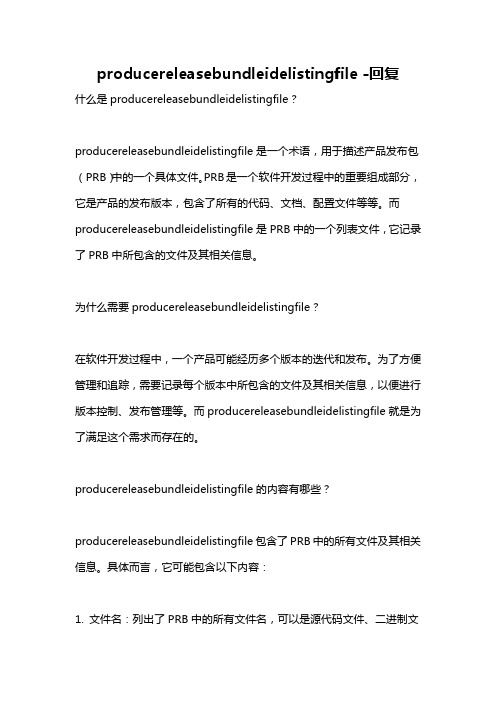
producereleasebundleidelistingfile -回复什么是producereleasebundleidelistingfile?producereleasebundleidelistingfile是一个术语,用于描述产品发布包(PRB)中的一个具体文件。
PRB是一个软件开发过程中的重要组成部分,它是产品的发布版本,包含了所有的代码、文档、配置文件等等。
而producereleasebundleidelistingfile是PRB中的一个列表文件,它记录了PRB中所包含的文件及其相关信息。
为什么需要producereleasebundleidelistingfile?在软件开发过程中,一个产品可能经历多个版本的迭代和发布。
为了方便管理和追踪,需要记录每个版本中所包含的文件及其相关信息,以便进行版本控制、发布管理等。
而producereleasebundleidelistingfile就是为了满足这个需求而存在的。
producereleasebundleidelistingfile的内容有哪些?producereleasebundleidelistingfile包含了PRB中的所有文件及其相关信息。
具体而言,它可能包含以下内容:1. 文件名:列出了PRB中的所有文件名,可以是源代码文件、二进制文件、配置文件、文档等等。
2. 文件路径:记录了每个文件的路径信息,方便在需要时能够快速找到文件的具体位置。
3. 文件大小:记录了每个文件的大小,可以用来评估PRB的大小,判断是否过大或过小。
4. 文件类型:标识了每个文件的类型,可以是源代码、二进制、文档等等。
5. 版本信息:记录了每个文件所属的版本号,方便进行版本控制和追踪。
6. 文件更新日期:记录了文件的最后更新日期,可以用来判断文件是否为最新版本。
7. 文件作者:记录了文件的作者信息,方便进行责任划分和代码审查。
8. 文件描述:对每个文件进行简要的描述,包括文件功能、用途等信息,方便其他开发人员理解和使用。
PRD模板案例
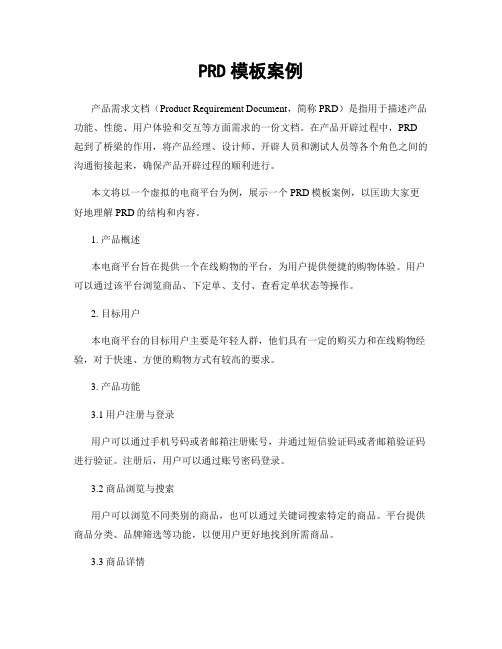
PRD模板案例产品需求文档(Product Requirement Document,简称PRD)是指用于描述产品功能、性能、用户体验和交互等方面需求的一份文档。
在产品开辟过程中,PRD 起到了桥梁的作用,将产品经理、设计师、开辟人员和测试人员等各个角色之间的沟通衔接起来,确保产品开辟过程的顺利进行。
本文将以一个虚拟的电商平台为例,展示一个PRD模板案例,以匡助大家更好地理解PRD的结构和内容。
1. 产品概述本电商平台旨在提供一个在线购物的平台,为用户提供便捷的购物体验。
用户可以通过该平台浏览商品、下定单、支付、查看定单状态等操作。
2. 目标用户本电商平台的目标用户主要是年轻人群,他们具有一定的购买力和在线购物经验,对于快速、方便的购物方式有较高的要求。
3. 产品功能3.1 用户注册与登录用户可以通过手机号码或者邮箱注册账号,并通过短信验证码或者邮箱验证码进行验证。
注册后,用户可以通过账号密码登录。
3.2 商品浏览与搜索用户可以浏览不同类别的商品,也可以通过关键词搜索特定的商品。
平台提供商品分类、品牌筛选等功能,以便用户更好地找到所需商品。
3.3 商品详情用户点击商品后,可以查看商品的详细信息,包括商品图片、价格、库存、描述等。
用户还可以查看商品的评价和评论。
3.4 购物车用户可以将心仪的商品加入购物车,方便后续统一结算。
用户可以随时查看购物车中的商品和总价,并可以对商品进行增删操作。
3.5 下单与支付用户可以选择购物车中的商品进行下单,并选择支付方式。
平台支持多种支付方式,如支付宝、微信支付等。
用户需要填写收货地址和联系方式。
3.6 定单管理用户可以查看自己的定单列表,并查看定单的状态(待付款、待发货、待收货、已完成等)。
用户可以取销定单、申请退款等操作。
3.7 售后服务用户可以在定单完成后申请售后服务,如退货、换货、维修等。
平台会根据具体情况进行处理,并提供相应的售后服务。
4. 非功能需求4.1 安全性平台需要保障用户的个人信息安全,采取相应的加密措施,防止信息泄漏。
咨询产品信息英语作文模板
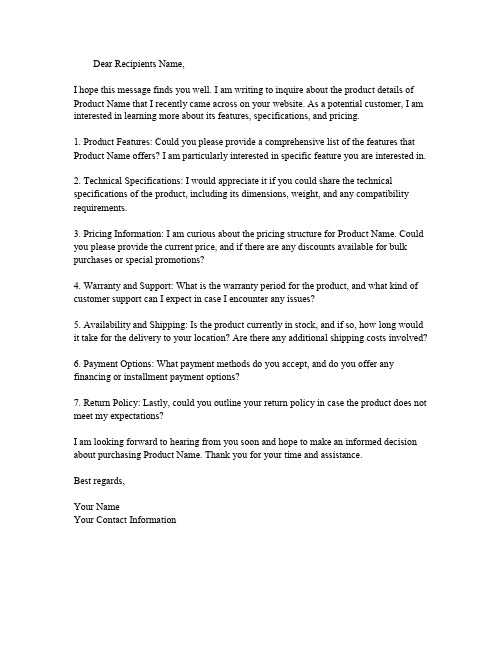
Dear Recipients Name,I hope this message finds you well. I am writing to inquire about the product details of Product Name that I recently came across on your website. As a potential customer, I am interested in learning more about its features, specifications, and pricing.1. Product Features: Could you please provide a comprehensive list of the features that Product Name offers? I am particularly interested in specific feature you are interested in.2. Technical Specifications: I would appreciate it if you could share the technical specifications of the product, including its dimensions, weight, and any compatibility requirements.3. Pricing Information: I am curious about the pricing structure for Product Name. Could you please provide the current price, and if there are any discounts available for bulk purchases or special promotions?4. Warranty and Support: What is the warranty period for the product, and what kind of customer support can I expect in case I encounter any issues?5. Availability and Shipping: Is the product currently in stock, and if so, how long would it take for the delivery to your location? Are there any additional shipping costs involved?6. Payment Options: What payment methods do you accept, and do you offer any financing or installment payment options?7. Return Policy: Lastly, could you outline your return policy in case the product does not meet my expectations?I am looking forward to hearing from you soon and hope to make an informed decision about purchasing Product Name. Thank you for your time and assistance.Best regards,Your NameYour Contact Information。
《ISPE 调试和确认指南(第二版)》关键变化解读

操作验证(OV):在所有指定的操作范围内,根据书面和预先批准的 规范审查,测试,检查或以其他方式建立和记录系统的活动。
TOP/VDR: 移交文件包和供应商交付文档要求。
关键变化
5
组件关键性评估(CCA) :由于CDE被确定为系统风 险评估的输出,因此无需评估每个系统组件的关键性。 提出针对调试验证的GDP要求。 间接影响被取消。 产品影响属性:关键的公用工程,如注射用水(WFI) 系统,可能没有产品CQA,但确实有药典要求和CPPs, 且影响产品CQA交付。这些参数可以称为关键参数,但 不能称为最终产品质量属性。本指南的作者继续对所有 系统使用CPPs和CQA术语,包括 WFI和上游设备。
优先考虑尽可能快速和经济地交付项目,同时满足法规要求。
试图解决: l 对监管合规要求的任何不确定性都可能推高成本并阻碍创 新和技术进步 l 提供一个合规、综合科学和基于风险的方法,使调试和确 认过程高效和具有成本效益。
3
以下领域不在本指南所述的C&Q流程范围内: l 产品和工艺开发,包括识别影响系统设计的任何工艺要求 l 计算机化系统软件开发和测试(参见ISPE GAMP&5:基于
CQA,CPP,CA,CDE和相关测试之间的关系。
6
自动温度控制和过程步骤监控示例
V-模型取消?
7
V-模型取消?
8
u V模型恰当地代表了设计过程和测试之间的联系,但没有包含基于产品 质量的风险评估过程,被新的流程模型取代。
u 顺序型:V模型,充分了解拟交付的产品;有丰富的行业实践经验;整 批一次性交付产品有利于干系人。
- 1、下载文档前请自行甄别文档内容的完整性,平台不提供额外的编辑、内容补充、找答案等附加服务。
- 2、"仅部分预览"的文档,不可在线预览部分如存在完整性等问题,可反馈申请退款(可完整预览的文档不适用该条件!)。
- 3、如文档侵犯您的权益,请联系客服反馈,我们会尽快为您处理(人工客服工作时间:9:00-18:30)。
Explicit, non-integrated product placement in British television programmesRungpaka Tiwsakul, University of DurhamChris Hackley Royal Holloway, University of LondonIsabelle Szmigin University of Birmingham Business SchoolPre-publication copy. Please cite asTiwsakul, R., Hackley, C. and Szmigin, I. (2005) Explicit, Integrated Product Placement in British Television Porgrammes, International Journal of Advertising, 24(1), pp. 95–111. AbstractThe rapid increase in the volume and variety of product placement approaches has outpaced research in the field. There is a marked shortage of studies that address particular product placement (pp) techniques in specified situational contexts. This paper reports the category of pp known as explicit, non-integrated product placement in the context of British television programmes. The study used a small convenience sample of young, mixed-nationality TV viewers who were familiar with the British and non-British shows on British commercial TV. Their attitudes to and recognition of pp in this context were explored. The findings are set within a wider-ranging review of previous research, and suggest important implications for promotional practice and future research.Introduction‘Product placement’ in its var ious forms has become a major arm of the promotional mix in recent years. The media landscape has changed with industry deregulation in many countries and the evolution of new media technologies with global reach. Audiences have fragmented and grown sceptical towards conventional advertising, the result being that advertising is seen as ill-equipped, on its own, to facilitate integrated brand communications strategies. Product placement strategies have evolved from the ‘showing the can’ approach to become increasingly sophisticated. Some researchers (e.g. Karrh 1998) argue that ‘brand placement’ is a more appropriate term for capturing the scope of placement activities, although product placement remains the more common catch-all term in the literature.While the growing importance of product placement is reflected in increased attention from researchers there is still relatively little published research on the specific categories of product placement in particular media segments. Previous studies in the area of product placement reported its effects on audiences’ brand recall, recognition and attitudes, and revealed the level of acceptance of product placement in general (e.g. Gupta & Gould 1997; d’Astous & Seguin 1999; Russell 2002). Much empirical research on the topic fails to distinguish between the various product placement techniques. There is a also a general failure to differentiate between media vehicles, often referring to ‘movies’ to mean all broadcast film drama. A further drawback of such research is that the emphasis on recall and attitudes cannot fully explain the quality of consumer engagement with product placement and therefore can offer only limited insights into its effectiveness.This paper reports a UK-based study that focuses on a previously unresearched area, namely explicit, non-integrated product placement in British television programmes. Non-integrated explicit product placement is defined in this study as ‘a branded product which is formally expressed but is not integrated within the contents of the television programme’(d’Astous & Seguin 1999). In this form of pp, the sponsor’s name might be presented in some form at the beginning or the end of the programme, and/or either side of the commercial break.The importance of television for explicit non-integrated product placementTelevision programmes are identified as the focus of this research for several reasons. First, product placement in television programmes may be more effective than in movies. A film is usually an entity in which a character’s story ends with the movie, whereas a television programme’s lead characters appear to live in similar time-scales to their audiences so that audiences can relate to them in terms of familiarity and identification (Russell 1998). In addition, regular viewers become deeply involved in storylines, and develop an intense and persistent loyalty to the programme and its characters (Avery & Ferraro 2000). A further point is that television programmes represent the beliefs, values, ideologies and worldviews that are held in each culture (Russell 1998). The television programme is a symbolic tool that forms and reflects prevailing cultural values. There are a limited number of studies of product placement in the area of television programmes, and none regarding non-integrated explicit product placement. Most general studies of product placement were conducted in the US. As the cultural context of product placement is self-evidently important in making the brand reference appear plausible and appropriate, there is a need for more culturally specific studies in this field.The scope of product placementDefinitions of product placement typically refer only to given categories of the practice. Balasubramanian (1994) referred to product placement as a ‘paid product message aimed at influencing movie (or television) audiences via the planned and unobtrusive entry of a branded product into a movie (or a television programme)’ (p. 31). d’Astous and Chartier (2000) defined product placement as ‘the inclus ion of a product, a brand name or the name of a firm in a movie or in a television programme for promotional purposes’ (p. 31). Ford (1993) referred to product placement as ‘the inclusion of a product or service within a film or programme in return for payment in cash or in kind to the producer or broadcaster’ (p. viii). Baker and Crawford (1995) defined product placement as ‘the inclusion of commercial products or services in any form in television or film productions in return for some sort of payment fro m the advertiser’ (p. 2). Product placement, according to Gupta and Gould (1997), involves incorporating brands into movies in return for money or for some promotional or other considerations.All the above definitions provide interesting concepts of product placement, but each omits some important aspects. Although the paid nature of product placement is included in all definitions, only the movie and television types of media are mentioned. There are in fact many other media and other forms of pp, such as computer or video games, promotional contests and websites, to name but a few. Nelson (2002) has commented on this development of the practice: ‘By 1995, the increasing use of product placements in entertainment vehicles other than television or film was noted’ (p. 81).Product placement can be viewed as a hybrid message due to its ‘hidden but paid’ nature (Balasubramanian 1994). Effectively, it is a promotion placed in a non-promotional entertainment context, where the promotional intent is not made explicit. Consequently the meaning of the brand in the placement context may not be construed in the same way as it might be in the context of an explicit advertisement. The development of increasingly subtle forms of pp further challenges the explanatory value of given definitions.Categories of product placementProduct placement strategies are generally classified into three main types: implicit product placement, integrated explicit product placement and non-integrated explicit product placement. Implicit product placement refers to the placement of a branded product within a television programme without being formally expressed. It plays a passive and contextual role. For example, in the US television series Friends, there was a scene in one episode where Rachel flew to Ross’s wedding in London in a Virgin plane (and Richard Branson had a cameo role). Branded products are often seen on a shelf in a shop in the popular UK TV soap EastEnders; however, there is no explicit reference made to sponsorship in the script or credits. A branded product that is formally expressed within a television programme is defined as an integrated explicit product placement: it plays an active role. In this type of product placement the benefits and attributes of the product are clearly demonstrated. For instance, characters in the pubs in UK shows Coronation Street, Emmerdale and (the now defunct) Brookside choose Carlsberg when they want a drink; Tom Cruise drinks Guinness in the film Minority Report. In non-integrated explicit product placement a branded product is formally expressed but it is not integrated within the contents of the television programme. The sponsor’s name is presented at the beginning, during or at the end of the programme; for example, ‘Sex and the City wa s sponsored by Bailey’s’ or ‘A Mini drama with Cold Feet’. Product placement can also be categorised in terms of its modality and relevance. Russell (1998) employed the categories screen placement, script placement and plot placement. Screen placement is a visual type of placement. It involves placing a brand in the scene of a movie or television programme. Script placement is an auditory or verbal type of placement.A branded product is mentioned in a dialogue in this category. Plot placement refers to the combination of visual and verbal components. In this type of placement, a brand or product becomes a part of the plot or takes a major place in the storyline. The subtlety of the connection between brand reference and plot is important. Current wisdom among Hollywood agents handling brand placement in movies is that the portrayalo f the brand must ‘tell a story’ because simply ‘showing the can’ does not offer a sufficiently powerful narrative context to enhance the brand identity (Hackley 2003).Research approachSoap operas and mini-series on British terrestrial channels (i.e. BBC1, BBC2, ITV1, Channel 4 and Five) were the main focus of the study. Published sources and research databases were used as secondary sources in order to set the present study within a broader context of contemporary research in the field. The primary data gathering entailed in-depth interviews and questionnaires. A pilot study was first implemented to test the questionnaire.The questionnaire used was adapted from Gupta and Gould’s study (1997). It was divided into four sections: questions about the attitudes towards product placement; the acceptability of product placement in different product categories; the awareness of the linkage between brands and television programmes; demographic and individual differences. Product placement was defined on the front page of the questionnaire. A total of 23 statements werepresented and respondents were asked to indicate their attitudes according to a five-point Likert scale. Product categories were chosen that consisted of alcohol, non-alcoholic beverages, books, cameras, sweets/snacks, cars, computers, cosmetics, medicines, food, jewellery, lingerie, magazines, motorcycles, films, musical instruments, music, telephones, televisions, sports goods, sunglasses, tobacco, toys, watches, weapons and white goods. The third section of the questionnaire comprised two parts. The first asked if respondents had watched the given programmes within the last three months. The second asked respondents to fill in the name of the brands that sponsor the given television programmes. There were 11 television programme titles provided in the questionnaire: Friends, Sex and the City, Coronation Street, Hollyoaks, ER, The Osbournes, Big Brother, Blind Date, Cold Feet, Wish You Were Here and Will and Grace.Both in-depth interviews and questionnaires were used to widen the scope of possible responses. The data were analysed using thematic analysis of the in-depth interview transcripts and SPSS programme for questionnaires. Non-probability convenience sampling was used. The sample was drawn from staff and postgraduate students at a major UK‘redbrick’ university.As consumers’ attitudes towards product placement are influencedby a multitude of factors, the chosen respondents varied in terms of age, gender, education level and nationality. There were 50 respondents in the sample. These included 22 males (44%) and 28 females (56%). Most of them were 18 to 25 years of age (68%), although 24% were 26 to 35, 4% were 36 to 45, 2% were 46 to 55 and 2% were 56 to 65 years old. The respondents were mainly British (44%), 20% had an Asian background (Thai, Japanese and Korean), 12% were Indian, a total of 10% were French, Danish and Venezuelans, 8% were Chinese, 2% were Irish, 2% were Caribbean and 2% were African. The majority of respondents had Master’s degree education level (52%) and spent up to two hours watching television per day (60%).Analysis and discussion of findingsThe major findings of this empirical study supported previous studies, but some new insights also emerged. Findings can be summarised as follows. • Effectiveness in terms of a direct sales effect of non-integrated explicit product placement is inconclusive.• In general, respondents display favourable at titudes towards product placement and non-integrated explicit product placement strategies.• Respondents indicated a preference for product placement to more intrusive promotional techniques such as advertising.• Perceptions of subconscious (subliminal) effects and the use of ethically charged products are the major ethical concerns that should be considered in product placement.• There were gender differences between the degree of acceptance that respondents expressed in the ethically charged product categories (e.g. weapons, alcohol).• Respondents displayed relatively low brand recall in all given television programmes regarding the non-integrated explicit product placement strategy.A majority of respondents (64%) said that they had heard the expression ‘product placement’ before. The findings should be interpreted in the light of the relatively sophisticated understanding of this sample group. A further consideration is that the cultural specificity of the TV programming (British) as opposed to that of the respondents cannot be discountedas an influence on findings. Three main headings are used to reflect the priorities of previous studies within the discussion of the present findings:(1) attitudes, (2) ethical issues and (3) brand recall/purchase behaviour.Attitudes to product/brand placementIn general, respondents in this study displayed favourable attitudes towards product placement. This finding concurred with previous studies (e.g. Nebenzahl & Secunda 1993; Karrh 1998). According to the findings from questionnaires, 58% of the respondents agreed with the statement ‘I don’t mind if brand name products appear in television programmes.’They also stated that they did not mind if television programme producers received money or other compensation from manufacturers for placing their brands in the programmes (50%). In addition, 40% of the respondents disagreed with the statement ‘I will not watch a television programme if I know beforehand that brands are placed prominently in the programme for com mercial purposes’ and they had neutral attitudes towards ‘I hate seeing brand name products in television programmes if they are placed for commercial purposes’ (42%). They disagreed with the statement ‘Manufacturers are misleading the audiences by disguis ing brands as props in television programmes’ (40%) and ‘Product placementi n television programmes should be completely banned’ (34%). These general results were corroborated by the qualitative interview data. Product placement was regarded as ‘OK’ by most interviewees, with comments such as ‘I like it’, ‘it doesn’t affect me at all’ and ‘there’s nothing wrong with it’. They stated, ‘it’s [product placement] – another form of advertising’, ‘it’s a way to promote products’, ‘it has meanings’, ‘it’s a market ing tool’ and ‘it’s a way to advertise products’.The respondents in this study did not express strongly negative attitudes towards traditional advertising. This was incongruent with prior studies (e.g. Karrh, 1998; Gupta et al. 2000). Respondents had neutral attitudes towards the statement ‘When advertising appears on my television, I stop looking on the screen until the programme starts again’ (34%). However, 38% of the respondents agreed that they frequently flipped channels to escape watching advertising while viewing a television programme. This result concurred with previous studies which suggested that audiences tended to avoid advertising by zapping (Avery & Ferraro 2000; Pervan & Martin 2002). Respondents preferred product placement to traditional advertising for several reasons. First of all, product placement can enhance the realism of television programmes. Most of the respondents (58%) agreed with the statement ‘The presence of brand name products in television programmes makes them more realist ic.’ The respondents also preferred to see real brands in television programmes rather than fictitious brands (46%). These findings concurred with previous studies (e.g. Nelson 2002). As quoted in Russell (1998), placing real branded products in television programmes can intensify the authenticity and salience of those programmes (Shermach 1995). Nevertheless, the respondents suggested that television programmes should contain only those brand name products that were complementary to the programme’s realism (46%). Respondents felt that product placement increased their brand awareness. Some respondents pointed out, ‘it [product placement] makes me recognise the brand’ and ‘it makes me remember it more’. Many felt that product placement represents a relatively unobtrusive form of marketing communications: ‘it’s less annoying than advertising’ and ‘it’s more subtle than advertising’ were comments recorded. One respondent also commented, ‘product placement is a good way to put products forward without having loa ds of adverts in the middle of programmes’. Furthermore, according to the results from interviews, a respondent said that product placement was more interesting than traditional advertising. Finally, product placement can build the image of products by using celebrities.According to Karrh (1998), product placement can be viewed as being as powerful as a celebrity endorsement but more subtle; indeed, respondents stated that they would try the product that celebrities used in television programmes. One of the factors that has an impact on the success of product placement is that brand values need to match with the image conveyed by celebrities. Despite the respondents’ positive attitudes towards product placement, they suggested that the government should regulate the practice of product placement (48%) and brands placed in a television programme should be disclosed at the beginning, during or at the end of the programme (48%). This study, however, cannot suggest that respondents prefer non-integrated explicit product placement to other types of product placement strategy. This is due to the neutral attitudes of the respondents towards the statement ‘I prefer a sponsor’s name presented at the end of the programme rather than a brand or product appearing within the televisionprogramme’ (52%).Ethical issues in product placement practicesIn terms of ethical issues, the current research found several concerns that should be considered. One of the most important was the issue of the ‘subliminal’ effect of product placement, with 58% of respondents agreeing that television programme audiences were‘subconsciously’ influenced by brands they saw in television programmes. Some indicated that it was highly unethical to influence audiences by using brand name products in television programmes (34%). Most of them also considered product placement as disguised commercial advertising (52%). This can be corroborated by the interviews’ findings: one respondent claimed that product placement offended the right of consumers because we already saw a great deal of advertising. Some respondents said, ‘it’s unfair to consumers’.The respondents in this study were also concerned with product placement practices that targeted vulnerable groups, especially children. Moreover, the placement of ethically charged products was considered as less ethical than other product categories, with some 42% of the respondents agreeing with the statement ‘The use of ethically charged products in product placement should be banned from some television programmes.’This is consistent with the degree of acceptance that respondents had of product placement in different product categories. Weaponry was the most unacceptable product category (76%) when compared with other ethically charged products (66% for tobacco and 38% for alcohol). This result concurred with previous studies (Gupta & Gould 1997; Gupta et al.2000). Interestingly, this study discovered that medicine was also considered an unacceptable product category (50%). None of the previous studies reported on the question of medical products promoted through pp. Other product categories, namely non-alcoholic beverages, books, cameras, sweets/snacks, cars, computers, cosmetics, food, jewellery, lingerie, magazines, motor cycles, films, musical instruments, music, telephones, televisions, sports goods, sunglasses, toys, watches and white goods, were all considered acceptable.In order to explore gender differences as one of the important individual difference factors that could influence the degree of acceptance of product placement in the ethically charged product category, cross-tabulation was employed. According to the findings, alcohol was considered as an acceptable product category for both genders (52%), which was incongruent with Gupta and Go uld’s (1997) study. Males tended to perceive the placement of ethically charged products as more acceptable than did females.Brand recall and purchase behaviourThe majority of respondents had watched Friends (90%), Big Brother (70%) and Sex and the City (56%) within the last three months. For other given television programmes in the questionnaires, the respondents watched ER (44%), Hollyoaks (42%), Will and Grace (42%), Coronation Street (40%), The Osbournes (32%), Cold Feet (20%), Wish You Were Here (20%) and Blind Date (12%). Respondents generally reported relatively low brand recall. Comparing to other given programmes, the television programme sponsorship that received the highest brand recall was the Cadbury’s sponsorship of Coronation Street, which constituted 50%. O2, which sponsored Big Brother, had the second highest recall, which accounted for 40%. For other given television programmes, the respondents had relatively low levels of brand recall: Sex and the City (30%), ER (24%), Friends (20%), Hollyoaks (18%), Will and Grace (12%), Cold Feet (8%), Wish You Were Here (8%), The Osbournes (6%) and Blind Date (2%).The ability of respondents to recall brands that sponsored television programmes was unlikely to be influenced by whether the respondents watched those programmes; for example, only 40% of the respondents watched Coronation Street but Cadbury’s sponsorship of it achieved the highest brand recall (50%). Some 90% of the respondents watched Friends but only 20% could recall its sponsor. Nevertheless, there were three main factors that probably affected consumers’ ability to recall: sponsor–programme congruity, frequency of television watching and other supported promotional tools. First, the linkage between the sponsor and television programme is one of the important factors that can have an impact on consumers’ brand recall. As suggested by d’Astous and Seguin (1999), the stronger the link, the greater the impact on the sponsor’s image and the attitudes towards the sponsor itself.For example, Friends and Jacob’s Creek (the sponsor) share similar attributes and values, including inherent quality, sociability, reliability, familiarity and contemporary style. Second, the frequency of television watching may have an effect on consumers’ recall of the sponsors. In this study, the majority of the respondents (60%) spent only up to two hours per day watching television. This could possibly explain why respondents had a relatively low level of recall. Third, brand recall can be influenced by the use of other promotional tools to support the practice of product placement; for example, Cadbury, which sponsors Coronation Street, uses public relations and the sales promotions game ‘Watch and Win’ (on its website) to support the product placement. This can generate greater recall of the brand.This study did not find a strong relationship between pp and selfreported purchase behaviour. According to the findings from questionnaires, respondents mostly disagreed with the statement ‘I buy brands I see actors an d actresses using in television programmes’ (42%) and ‘I buy brands that sponsor television programmes I watch’ (46%). However, some respondents from the interviews stated that they might try the product they saw in television programmes. It should be borne in mind that pp would not usually be regarded as a ‘strong’ form of promotional communication and therefore a direct and contiguous sales effect might not normally be expected.Managerial implicationsThe findings reported are clearly subject to the inherent limitations of any small-scale study. Furthermore, the focus on UK television places the research in a particular cultural context. Nevertheless, the coincidence of findings with those of larger-scale studies conducted in parallel but differing sectors of pp practice are striking. The present findings suggest someimportant implications for marketers and practitioners, and these are now discussed in turn. RealismThere was general agreement among respondents that the use of product placement could enhance the realism of television programmes. Conversely, product placements that are incongruent with the programme’s narrative themes or image may create a mutually discordant effect that undermines the authenticity or credibility of both the ‘placed’brand and the TV show brand. As noted above, product placement approaches have developed in sophistication from the ‘show the can’ approach and, in some cases of TV or movie pp, entail close cooperation between the brand representatives, the studio and the scriptwriters. The involvement of brands in the creative development of independently produced entertainment vehicles is a relatively new development in mediated brand communication, sometimes called ‘embedded marketing’ (Hackley 2003).Sponsor–programme congruityIn addition to realism, the perceived linkage between the sponsor and the television programme influences the effectiveness of product placement. As quoted in d’Astous and Seguin (1999), the stronger the link, the greater the impact on the sponso r’s image and the attitudes towards the sponsor itself. Friends is a good example of sponsor–programme congruity. The theme of its product placement strategy ‘Like to enjoy Jacob’s Creek with Friends?’ resonates with the target audience.Sales effectiveness of product placementThere was no strong evidence in this or previous studies of a direct and contiguous sales effect deriving from pp exposure. Product placement should, therefore, not be viewed as a standalone promotional tool or a replacement of other promotional tools; rather, it should be employed as part of an integrated brand marketing communications strategy. Concomitantly, the effectiveness of pp should be considered in the light of broader communications objectives aimed at building brands and/or widening the brand appeal.Celebrity endorsement and ppAccording to Karrh (1998), product placement can be considered as powerful as a celebrity endorsement but more subtle. Celebrities can provide relevance and generate attention to a brand (Pervan & Martin 2002); the celebrity presence makes the viewer turn their head and notice the communication. In addition to this, product placement can reinforce product usage if the characters in television programmes help audiences vicariously acquire brand preference (Balasubramanian 1994). As noted above, effectiveness seems to depend on a match between the product/brand characteristics and those of the celebrity persona. Marketers should also be aware of the negative image associated with celebrities that can transfer negatively to the placed brand products.Ethical issuesCommunications professionals need to be aware of the ethical sensitivities of consumers: some of these seem heightened with respect to pp techniques. Weapons, tobacco and alcohol emerged as product categories of ethical concern. Medicine is another product category that。
